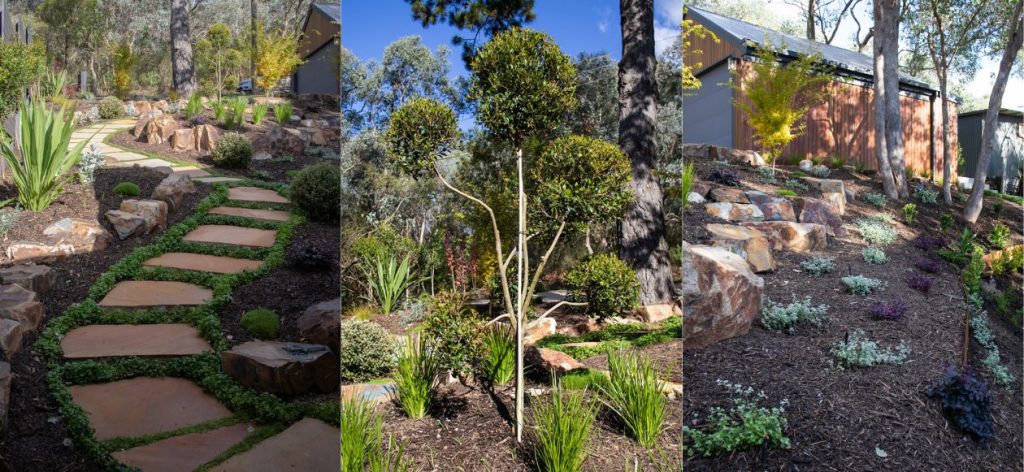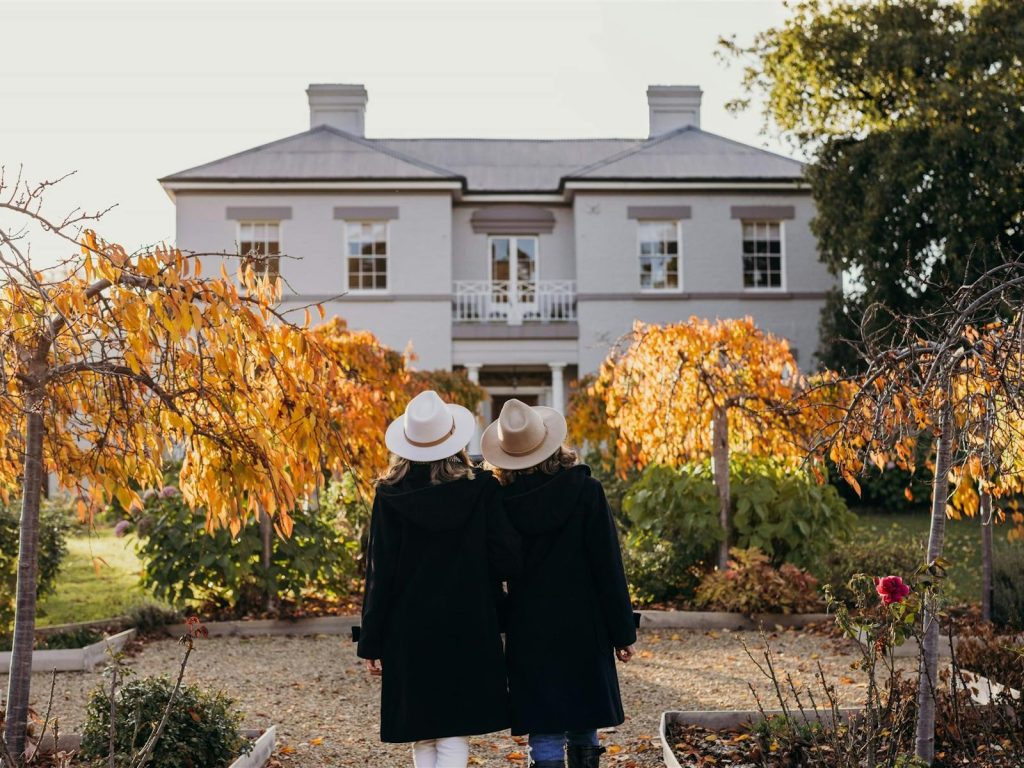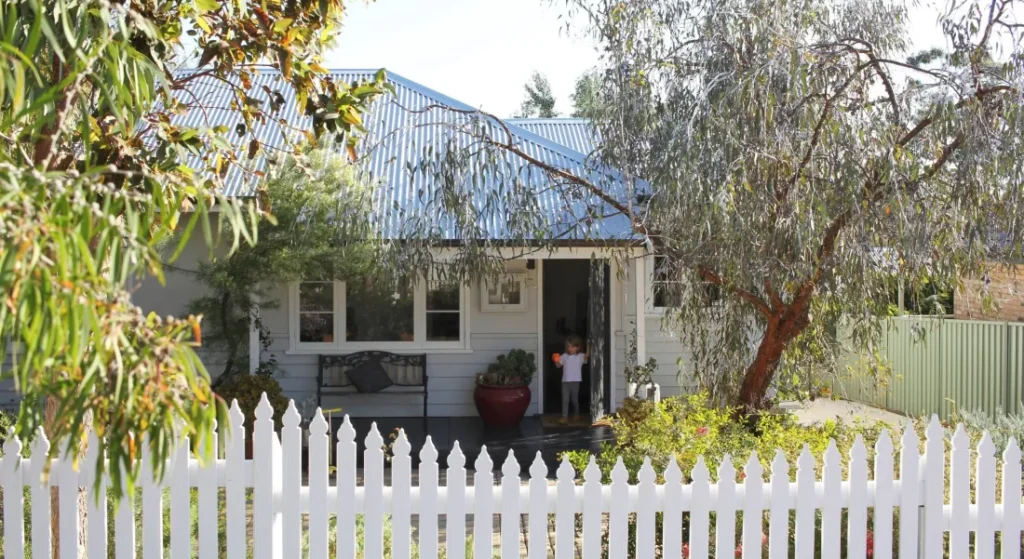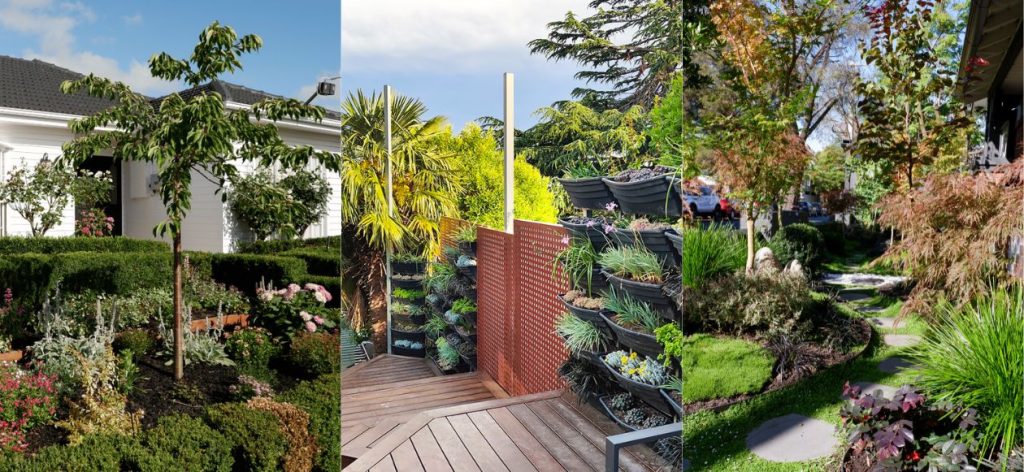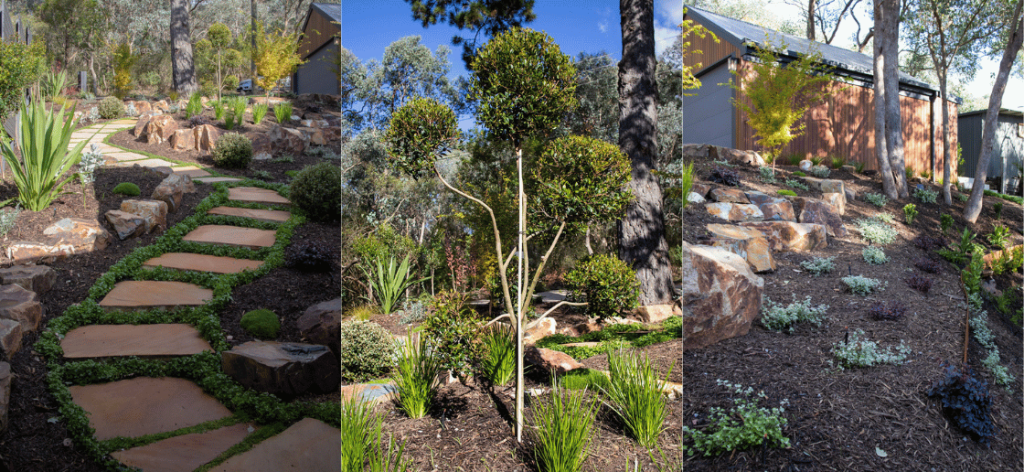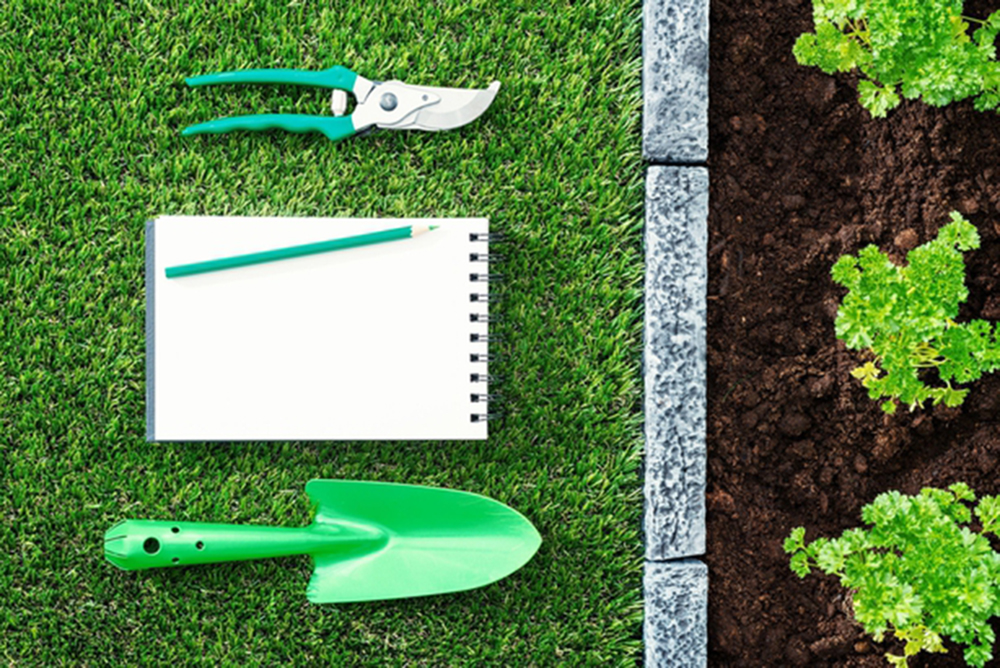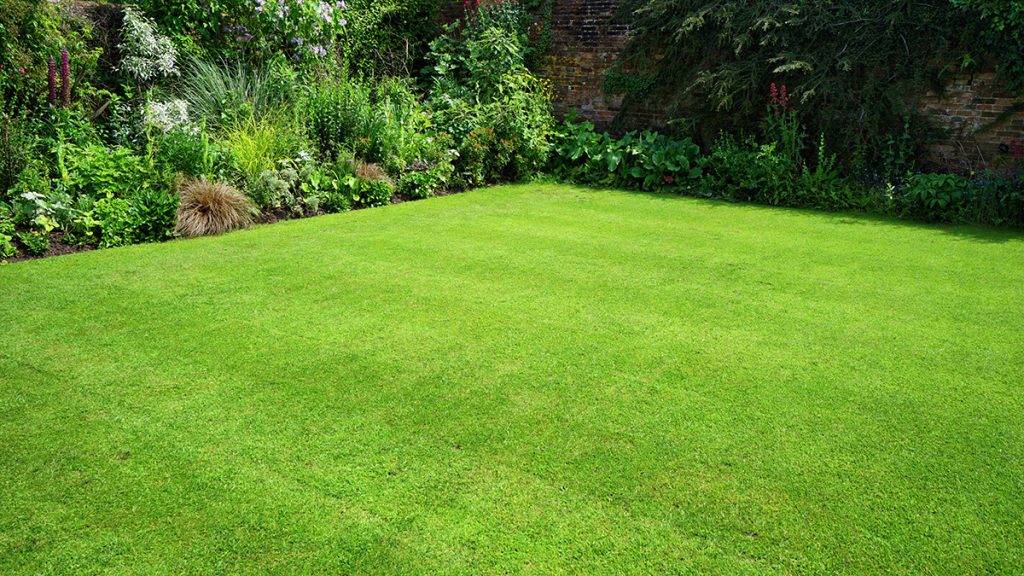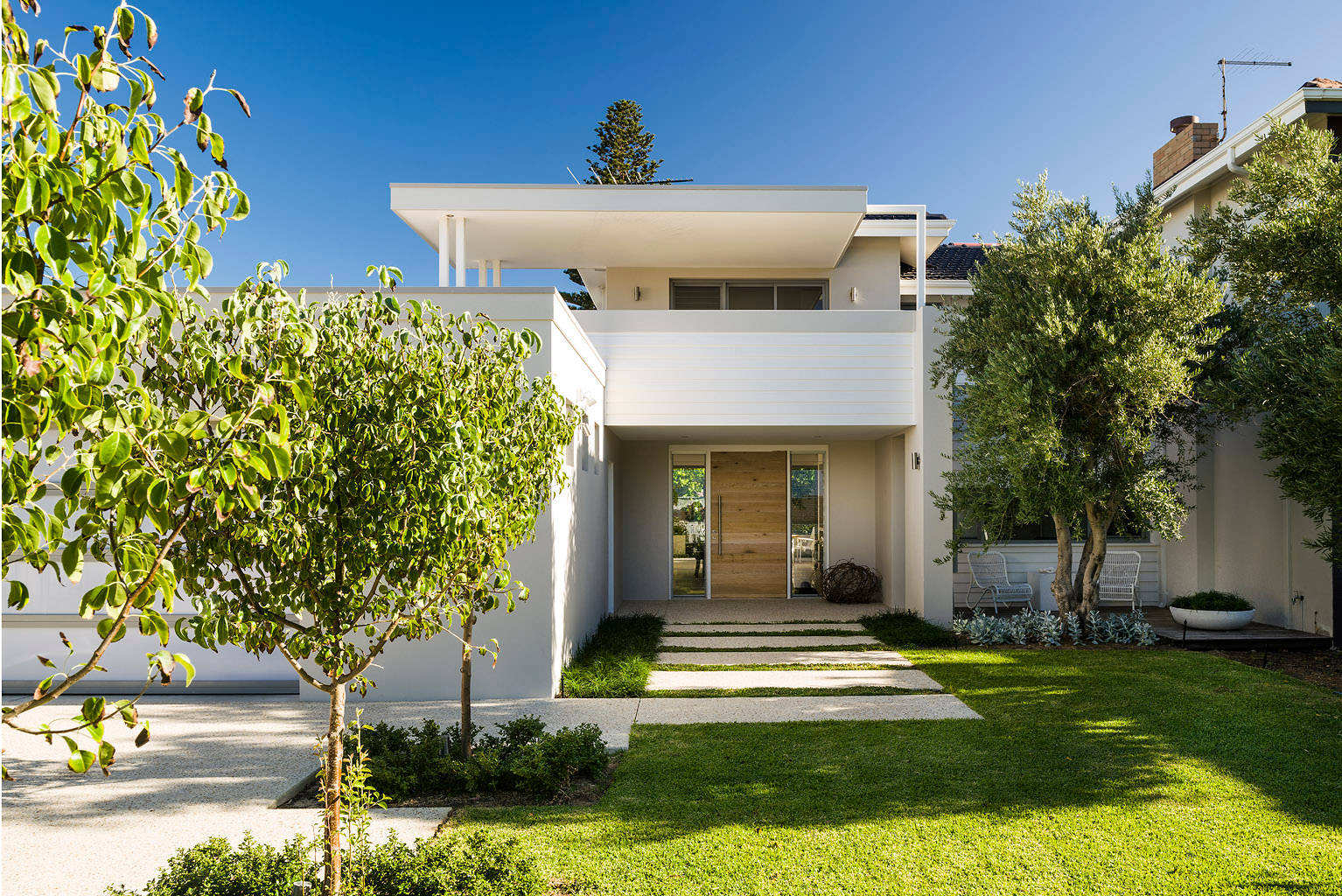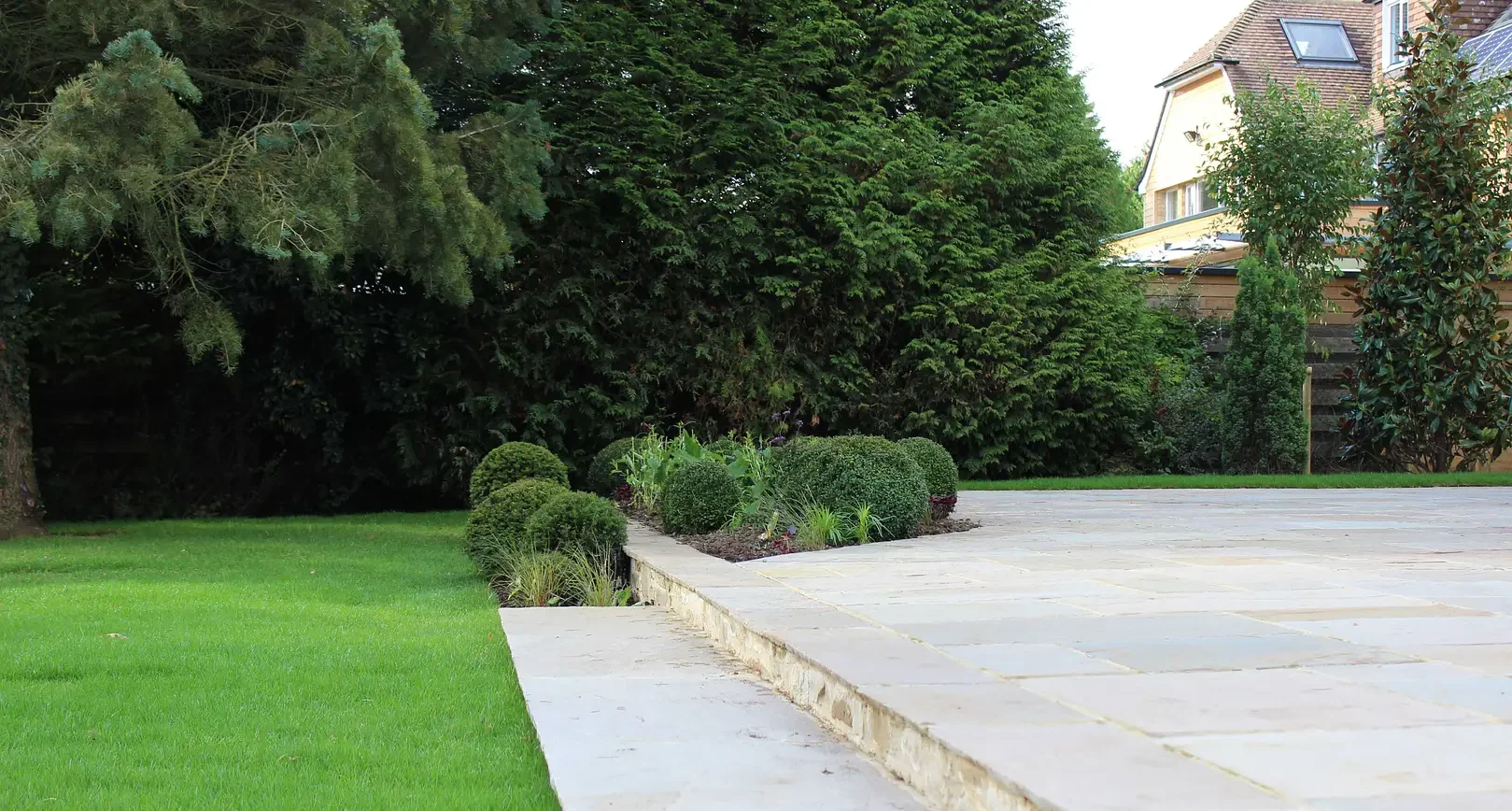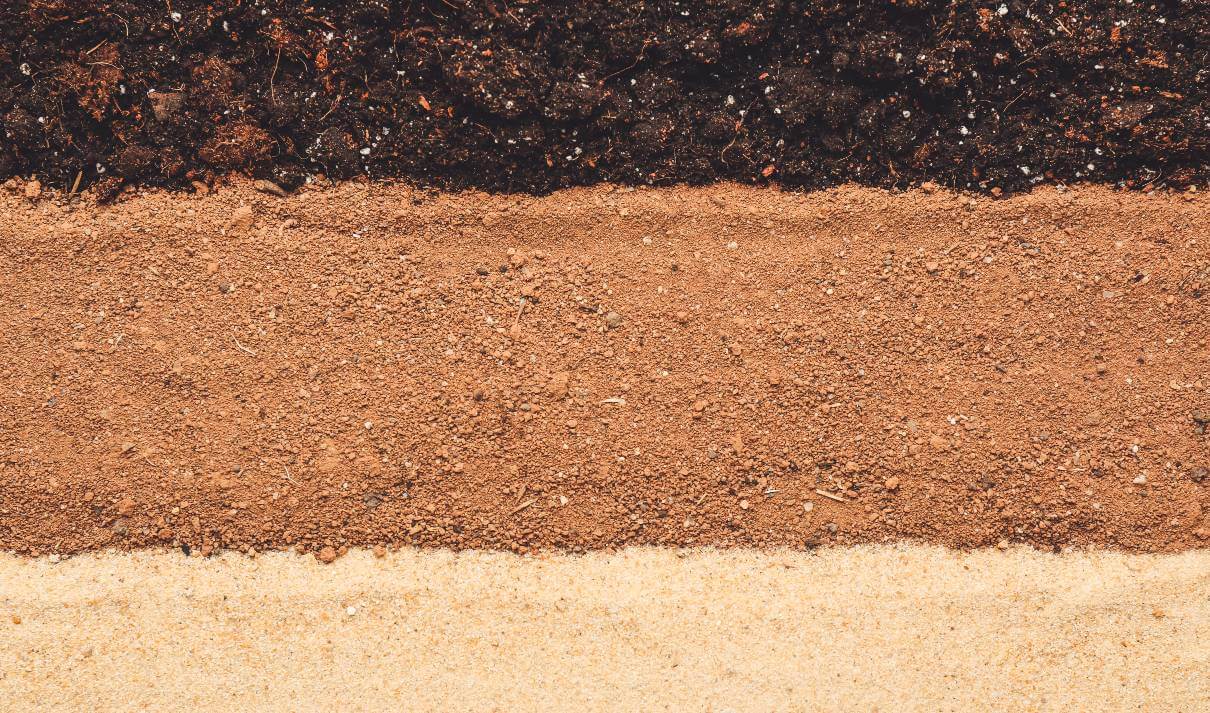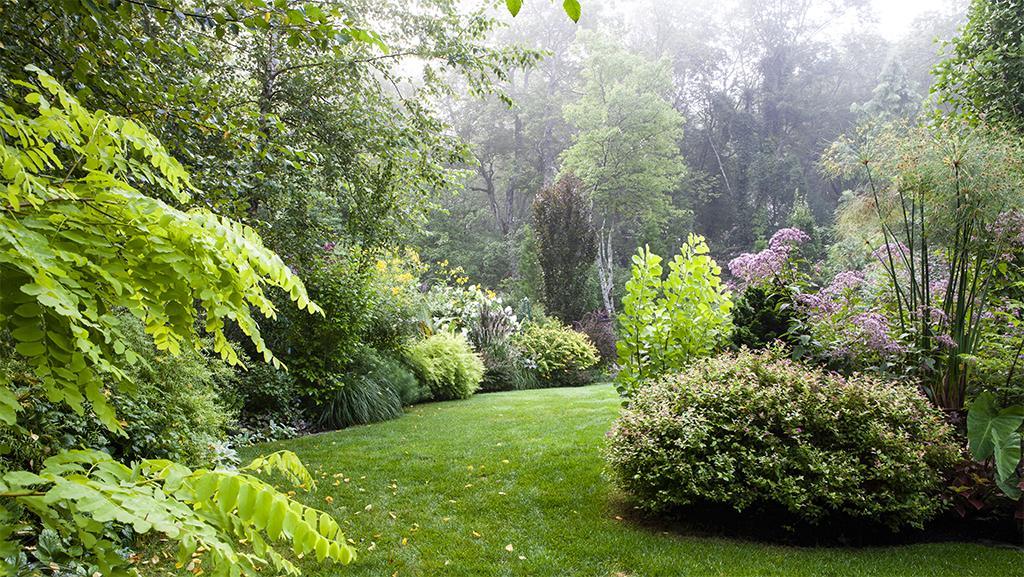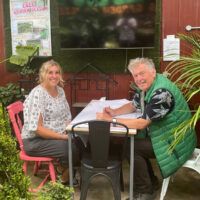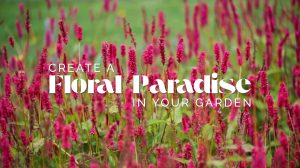The Process of Garden Design
Find the Assets & Liabilities
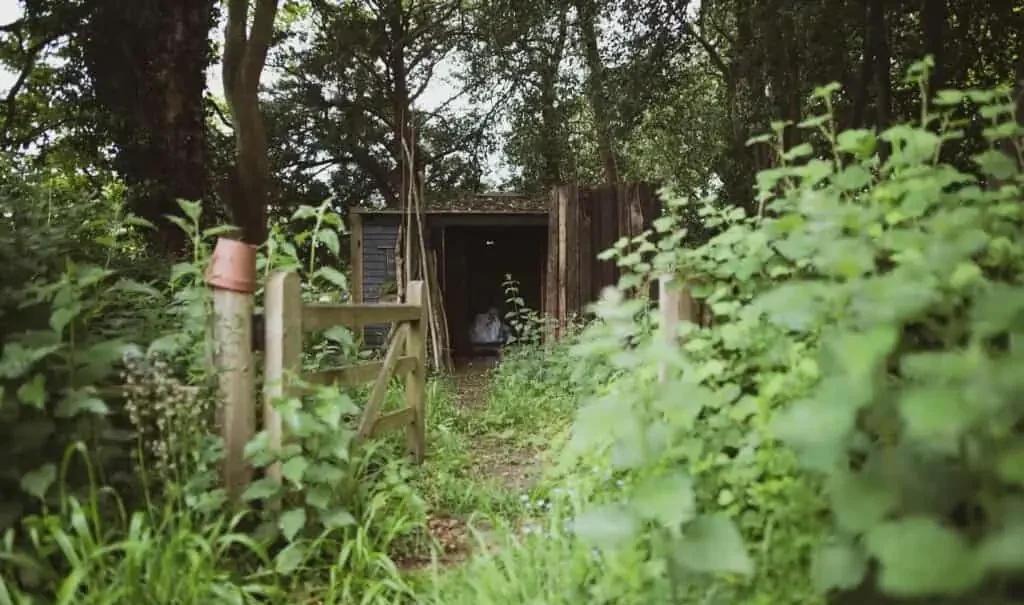
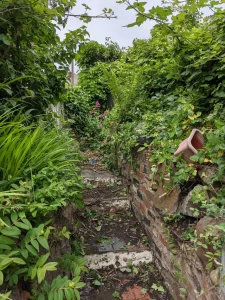 Now back in those days people used to say to me to just “chop all that stuff out” when it came to cleaning up these gardens in the hills – just chop it all out. But I didn’t like to just chop everything out. Now back then they had me on a super low budget so what I used to do is I would look at things and if there was a Weeping Cherry that could be salvaged and made into a beautiful tree with a bit of clever pruning or so on, it was much better to save it and keep it and make the most of it. So back in those days when I was 17, I learned that by fossicking through the bush or the jungle of these gardens that if I could find the assets and find the things that I could do something with, I would open it up and reveal it, and that would make that garden come to life.
Now back in those days people used to say to me to just “chop all that stuff out” when it came to cleaning up these gardens in the hills – just chop it all out. But I didn’t like to just chop everything out. Now back then they had me on a super low budget so what I used to do is I would look at things and if there was a Weeping Cherry that could be salvaged and made into a beautiful tree with a bit of clever pruning or so on, it was much better to save it and keep it and make the most of it. So back in those days when I was 17, I learned that by fossicking through the bush or the jungle of these gardens that if I could find the assets and find the things that I could do something with, I would open it up and reveal it, and that would make that garden come to life.
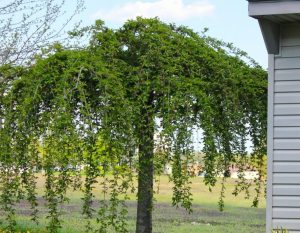 And I remember one time I saved a Weeping Cherry they had told me to cut down. I said just give me an hour to see if I can make you want to keep it. I recall the lady saying, “oh, I’m so glad we didn’t chop that cherry down. It looks fabulous now!” So I think that finding assets in your garden is really, really important. It’s the very first step I always take now when I assess a garden before doing anything to it.
And I remember one time I saved a Weeping Cherry they had told me to cut down. I said just give me an hour to see if I can make you want to keep it. I recall the lady saying, “oh, I’m so glad we didn’t chop that cherry down. It looks fabulous now!” So I think that finding assets in your garden is really, really important. It’s the very first step I always take now when I assess a garden before doing anything to it.
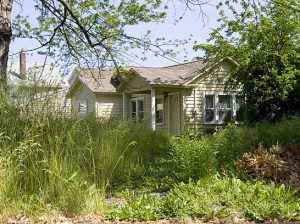 I’ll actually look at the garden and you can do this too, just actually sit there and make a balance sheet for the garden. What you do is ask yourself what’s really nice about this garden? So is it nice and big and wide and it’s got a bit of size to it? That could be an asset. A great view could also be an asset. Is it a cute cottage garden? Or is it a fabulous architect designed home? So what you’ve got to do first is find the assets. Now the assets could be that it’s just an interesting space or it could be that the garden has a lovely brick pathway. So you find the assets first.
I’ll actually look at the garden and you can do this too, just actually sit there and make a balance sheet for the garden. What you do is ask yourself what’s really nice about this garden? So is it nice and big and wide and it’s got a bit of size to it? That could be an asset. A great view could also be an asset. Is it a cute cottage garden? Or is it a fabulous architect designed home? So what you’ve got to do first is find the assets. Now the assets could be that it’s just an interesting space or it could be that the garden has a lovely brick pathway. So you find the assets first.
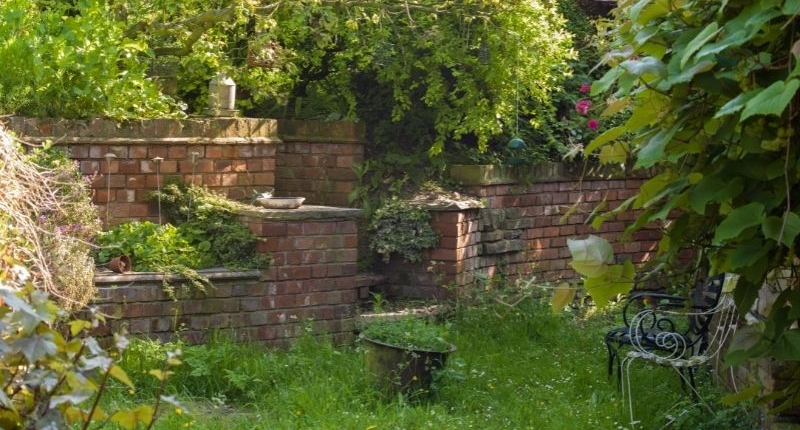
Now next, of course, you’ve got to find the liabilities too. Now this can be really hard because you have to be really critical and that can be hard for the average person. You’ve got to imagine that you’ve never seen that garden before and you’ve got to find out what is the most ugly bush in it? Or you might look at a tree and think “gee, I kinda like that tree!”. But what you’ve got to think about that tree is that if it didn’t look good in spring and it didn’t look good in autumn and it won’t look good tomorrow, chop it out.
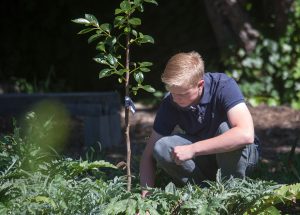 So in terms of liabilities, what you have to do is, you have to be ruthless. You have to say, well those taps over there and those meters look terrible, I’ve got to cover them up. So that’s a liability that has to be fixed. So you’ve got to focus attention on what are your assets and your liabilities and your assets need to jump out at you a little. So that’s the first step.
So in terms of liabilities, what you have to do is, you have to be ruthless. You have to say, well those taps over there and those meters look terrible, I’ve got to cover them up. So that’s a liability that has to be fixed. So you’ve got to focus attention on what are your assets and your liabilities and your assets need to jump out at you a little. So that’s the first step.
Take a Look
Now the second step is I look at the house. I don’t know if this is real or not but houses kind of talk to me so that’s where I start off and have a look at them. Now I did a garden four months ago. The customer came in and I looked at his garden and it was really boring and terrible. But what he did have was a brick fence at the front that actually matched the house. And that’s rare because often the brick fence doesn’t match the house, but this was a 100% original matching brick fence that had some fancy brickwork on it.
It was an old 40s or 50s house that was probably fairly upmarket in its day. It was very nice for its era and kind of cute. But the garden was a real liability. It was boring, flat, just nothing.
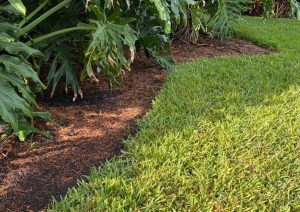
Now when I looked at this I thought, it’s a nice cute little space but one of my rules is if there isn’t enough room for a nice garden bed AND a nice lawn, then get rid of the lawn. And in this place, there just wasn’t enough room for both a lawn and a garden bed. Now I liked the house, I liked the brick fence out the front. I liked the age of the place and I liked the condition of it. But there wasn’t the big space for a lawn.
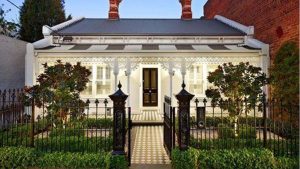 Then I thought, I don’t like gardens that are not in keeping with the age of the property. See I’ll often see a beautiful old Victorian house and people have used the latest slate for a great big black slate pathways or something like that and it doesn’t look so good. It just doesn’t go with the house.
Then I thought, I don’t like gardens that are not in keeping with the age of the property. See I’ll often see a beautiful old Victorian house and people have used the latest slate for a great big black slate pathways or something like that and it doesn’t look so good. It just doesn’t go with the house.
So I decided that we needed to do the sort of garden that might have been around 50 or 60 years ago. Then it would be something that really fitted in.
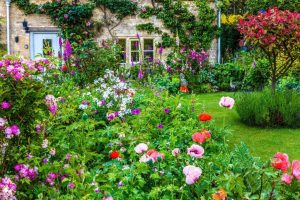 Now what I felt the garden wanted to be was an old-fashioned cottage style garden. So what we went for was a small Lilydale Toppings area in the middle of the garden where you could just sit and take in and enjoy the garden. Once I got that idea, I said to the owner of the property, why don’t you get on the Internet and see if you can get some old concrete ornaments? And they did that and they got some beautiful ones that to me just finish the garden off.
Now what I felt the garden wanted to be was an old-fashioned cottage style garden. So what we went for was a small Lilydale Toppings area in the middle of the garden where you could just sit and take in and enjoy the garden. Once I got that idea, I said to the owner of the property, why don’t you get on the Internet and see if you can get some old concrete ornaments? And they did that and they got some beautiful ones that to me just finish the garden off.
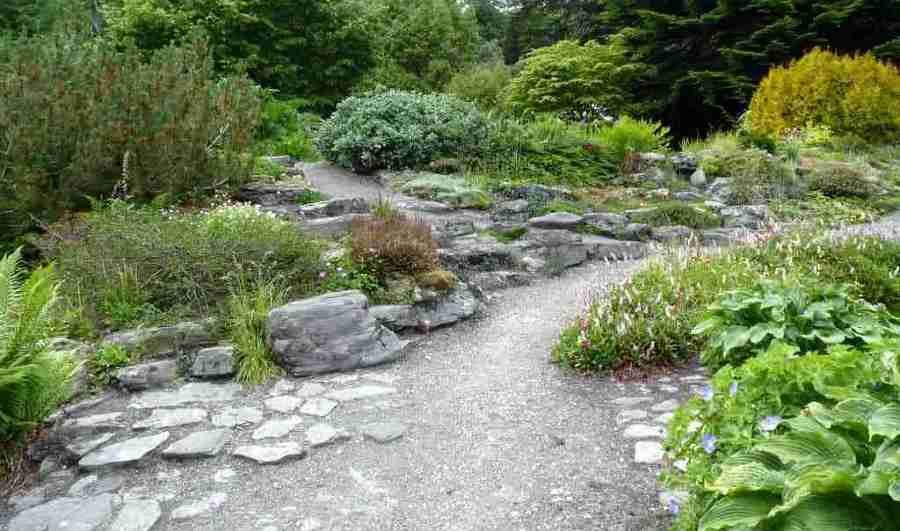
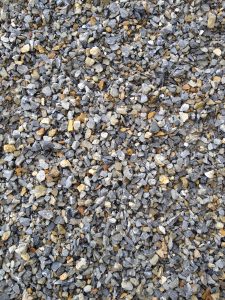 It’s lovely and simple. And it’s very, very inexpensive. Lilydale Toppings are not expensive or difficult to do. It didn’t take very long. Just some good soil preparation, there was quite a few hours involved in that. But the plants themselves were just a very simple selection of cottage plants and a couple of small trees. There’s a Weeping Silver Birch that’s never going to get too big and a Weeping Maple so the house is going to be obscured a little bit by the plants.
It’s lovely and simple. And it’s very, very inexpensive. Lilydale Toppings are not expensive or difficult to do. It didn’t take very long. Just some good soil preparation, there was quite a few hours involved in that. But the plants themselves were just a very simple selection of cottage plants and a couple of small trees. There’s a Weeping Silver Birch that’s never going to get too big and a Weeping Maple so the house is going to be obscured a little bit by the plants.
But basically it’s still going to be on show with this very cute cottage garden and this lovely Lilydale Toppings space in the middle with some ornaments and a seat there so the owners can sit out there and enjoy this garden. It’s quite a transformation.
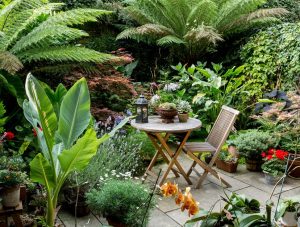 And the secret to it was I let the house speak to me, it really told me what it wanted. And then I used my simple rule that if you can’t put in a decent lawn, then go for no lawn. And by choosing that, the garden is actually quite big and looks big. A lot of gardens are so small now, but when you’ve got a small space, either do all lawn or all garden or all something but don’t try and do a lawn and a garden. If you stick to that rule you can turn a small space into something really worthwhile.
And the secret to it was I let the house speak to me, it really told me what it wanted. And then I used my simple rule that if you can’t put in a decent lawn, then go for no lawn. And by choosing that, the garden is actually quite big and looks big. A lot of gardens are so small now, but when you’ve got a small space, either do all lawn or all garden or all something but don’t try and do a lawn and a garden. If you stick to that rule you can turn a small space into something really worthwhile.
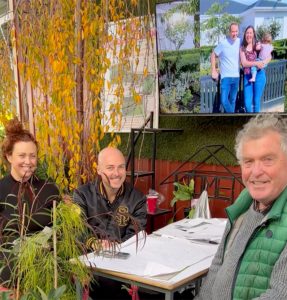 Now this garden was created using my Free Garden Design service. The way it works is this. You book a 20 minute design with me and you put down $50. And when the garden design is finished, if you purchase your plants for the garden with us and spend more than $250, you get your $50 back.
Now this garden was created using my Free Garden Design service. The way it works is this. You book a 20 minute design with me and you put down $50. And when the garden design is finished, if you purchase your plants for the garden with us and spend more than $250, you get your $50 back.
So it works out that you get a very good, very professional free garden design and instructions on how to go home and do it yourself. And in the end it costs you nothing for the design.
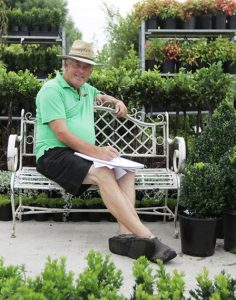 Now I mostly do these myself and I do up to six or seven a day. And if somebody is wanting to do a front garden AND a backyard, we have a longer session for 45 minutes but that costs more of course and you have to buy more plants to get it for free. It’s a great way to have somebody with a sort of an external viewpoint to your garden. But often I get people with very strong ideas of what they want. They know which plants or how to do it or where to start or whatever. And what’s good about my garden design is that I’ll work with you. Whereas what happens sometimes with other garden designers is that somebody talks to you, but then they go off, they do the garden design, they come back and they say, here it is. And you don’t really have much of a say in it.
Now I mostly do these myself and I do up to six or seven a day. And if somebody is wanting to do a front garden AND a backyard, we have a longer session for 45 minutes but that costs more of course and you have to buy more plants to get it for free. It’s a great way to have somebody with a sort of an external viewpoint to your garden. But often I get people with very strong ideas of what they want. They know which plants or how to do it or where to start or whatever. And what’s good about my garden design is that I’ll work with you. Whereas what happens sometimes with other garden designers is that somebody talks to you, but then they go off, they do the garden design, they come back and they say, here it is. And you don’t really have much of a say in it.
Whereas I do my garden designs right there in front of you so if I say, look, we should put some yellow roses in and you say, well, I hate yellow! Then I say, well, what colour do you like? By doing the design together with the person, I tend to get something done that you will like every aspect of.
Also, because we’ve got so many plants to choose from and I’ve got so many ideas that if you don’t like an idea for a plant or something, we can chuck it out and generate a new idea straight away. And I think the garden that is right for you is the garden where YOU like the plants and YOU like the design. There’s no “right garden” that I should impose on someone.
Work out the Priorities
Now a good garden does have to be the correct garden for that particular spot. But it also has to be the garden where you like the plants, you like the content, you like the layout, and you like the way it works for you and does what you want it to do. So one of the neat things I do when I’m designing a garden with someone is I’ll talk to you personally about things like I’ll say – look at the house, look at the assets and liabilities. I’ll say, what outcome do you want? And I try and understand what your level is at. Whether you are keen gardeners, whether you want some interesting plants or whether you just want to have something super low maintenance but that looks good. The truth is that everybody’s different. There is no one right garden that would fit everybody. And so it’s very, very important to discuss and work out what are a person’s priorities and to get them right.
Make a List
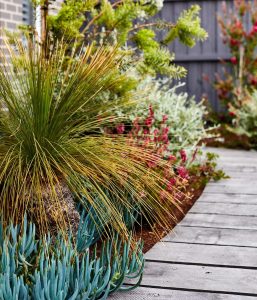 Often, I’ll write down on the top of the page that the No. 1 priority for this garden is that it must look good. Now No. 2 might be low maintenance. Or sometimes I might write No. 1 is low maintenance and No. 2 priority could be that the garden must be “Tropical” or whatever. So it’s good to prioritise what you really want before you come in for a garden design. I always recommend to people to walk around their neighbourhood and pick out what it is that they like or get some concept of what you are looking for in a magazine or go online and look at things that you like. This can help you work out what you like and don’t like and then give you some inspiration.
Often, I’ll write down on the top of the page that the No. 1 priority for this garden is that it must look good. Now No. 2 might be low maintenance. Or sometimes I might write No. 1 is low maintenance and No. 2 priority could be that the garden must be “Tropical” or whatever. So it’s good to prioritise what you really want before you come in for a garden design. I always recommend to people to walk around their neighbourhood and pick out what it is that they like or get some concept of what you are looking for in a magazine or go online and look at things that you like. This can help you work out what you like and don’t like and then give you some inspiration.
But the key thing is that you can also do this yourself if you’re doing your own garden design. And the first thing is to look at the whole garden and work out your assets and liabilities. Let your house start to talk to you and then start to put something together. As you start to put it together try and have some rules like I do.
Lawns
 The first rule I said before which is if you don’t have room for a decent sweeping lawn, forget the lawn – chuck it out! As I said before they didn’t need a lawn in that garden I talked about earlier. So if you don’t have a lawn, what are your alternatives you might ask? Well you can have a nice area for something like Lilydale Toppings to give you access to the garden. You can put stepping stones through the garden. You could mulch it. You could have all natives in your garden or go for a cottage garden if you’ve got a small space that just doesn’t have room for a lawn and a garden. That small space when you fill it with garden will actually look like a big space. Whereas if you try to have a lawn and a garden in a small space, it looks cramped.
The first rule I said before which is if you don’t have room for a decent sweeping lawn, forget the lawn – chuck it out! As I said before they didn’t need a lawn in that garden I talked about earlier. So if you don’t have a lawn, what are your alternatives you might ask? Well you can have a nice area for something like Lilydale Toppings to give you access to the garden. You can put stepping stones through the garden. You could mulch it. You could have all natives in your garden or go for a cottage garden if you’ve got a small space that just doesn’t have room for a lawn and a garden. That small space when you fill it with garden will actually look like a big space. Whereas if you try to have a lawn and a garden in a small space, it looks cramped.
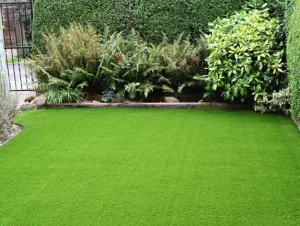 Now my next rule that I have about lawns is that I do my absolute best not to put a tree or not to put a circle or a square or a little garden bed in the middle of the lawn I think that a lawn, particularly if you’re fighting for space, the lawn should have its own space. So what I’ll tend to do when people want to say put a tree or a flower bed or something like that, in the middle of the lawn, I’ll tend to take a corner of the lawn or take two corners of the lawn and put the trees or the garden beds in the corners of it and have the lawn preserved and open.
Now my next rule that I have about lawns is that I do my absolute best not to put a tree or not to put a circle or a square or a little garden bed in the middle of the lawn I think that a lawn, particularly if you’re fighting for space, the lawn should have its own space. So what I’ll tend to do when people want to say put a tree or a flower bed or something like that, in the middle of the lawn, I’ll tend to take a corner of the lawn or take two corners of the lawn and put the trees or the garden beds in the corners of it and have the lawn preserved and open.
Ideally a lawn should sweep through from say the driveway through to the side path or something like that. So that a person could step off the drive, walk along the lawn and go somewhere. See I love a lawn that sweeps and goes somewhere, and I love that lawn to be unbroken.
Then the next rule I have is to minimise the number of garden beds. I once built a garden that was on a half-acre block and I built a garden bed that was 30 meters long and 6 metres wide. And I had little pathways going through it, leading from the house and the carport and stepping stones and little spots to sit in that garden. But it was just one enormous garden. And it was fantastic! It was a massive area with a beautiful collection of plants in it. But what was great about that garden is that it didn’t take you much time or effort to look after to keep it weeded and looking good.
Whereas I find, that it’s actually the number of garden beds that determine how much work you have to do in your garden and how much attention that the garden requires. So if you’re looking to have a nice collection of plants or flowers, it’s better to have less garden beds and instead just have one bigger garden.
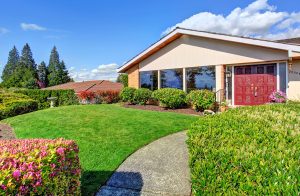 I think there’s this one odd thing in Australia, the way Australians have of doing a garden. They build a house and then they put a fence up and they put a driveway down one side and a garage and so on. And then what they do is they draw a line around the edge of everything and they make each area into a garden bed (see example left). So they have a little garden bed behind the fence, a garden bed beside the drive, a garden bed next to the garage, a garden bed next to the house, a garden here, a garden bed there…. You get what I mean. And there are just garden beds everywhere!
I think there’s this one odd thing in Australia, the way Australians have of doing a garden. They build a house and then they put a fence up and they put a driveway down one side and a garage and so on. And then what they do is they draw a line around the edge of everything and they make each area into a garden bed (see example left). So they have a little garden bed behind the fence, a garden bed beside the drive, a garden bed next to the garage, a garden bed next to the house, a garden here, a garden bed there…. You get what I mean. And there are just garden beds everywhere!
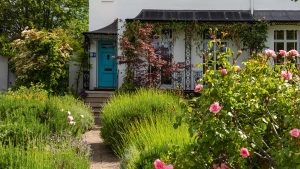 I really noticed this years ago when I was writing a little book on hedging and I grabbed all of these English magazines on gardening and real estate. And what I noticed is the English, don’t do that at all. They just put a garden out in the middle or out at the front. They don’t automatically put a little garden bed around the edge of everything.
I really noticed this years ago when I was writing a little book on hedging and I grabbed all of these English magazines on gardening and real estate. And what I noticed is the English, don’t do that at all. They just put a garden out in the middle or out at the front. They don’t automatically put a little garden bed around the edge of everything.
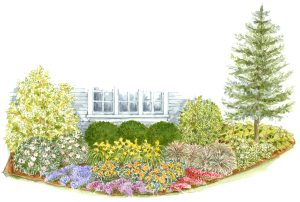 Ever since I observed this, when people come in and tell me about their plans for a garden and they say I’ve got this fence here and the house here and this wall here and what they’re going to end up with is lots of garden beds everywhere. And each of those garden beds actually have little impact. So I’ll often throw in a really big garden bed and get rid of all the little ones. That’s one of my things is to get rid of, say the one in front of the house, and get rid of that one up the path, and get rid of that one up the driveway and let’s do something really big along the front fence. Let’s make it really stand out. Let’s put some trees in there.
Ever since I observed this, when people come in and tell me about their plans for a garden and they say I’ve got this fence here and the house here and this wall here and what they’re going to end up with is lots of garden beds everywhere. And each of those garden beds actually have little impact. So I’ll often throw in a really big garden bed and get rid of all the little ones. That’s one of my things is to get rid of, say the one in front of the house, and get rid of that one up the path, and get rid of that one up the driveway and let’s do something really big along the front fence. Let’s make it really stand out. Let’s put some trees in there.
Oh that’s another thing. A lot of people come in with a lot of skinny little garden beds all around the place and they want to have nice big plants and trees in them, but there’s nowhere to put them. But with your bigger round garden beds or your bigger square garden beds, you’ve got room to express yourself, you’ve got room for bigger plants and bigger ideas.
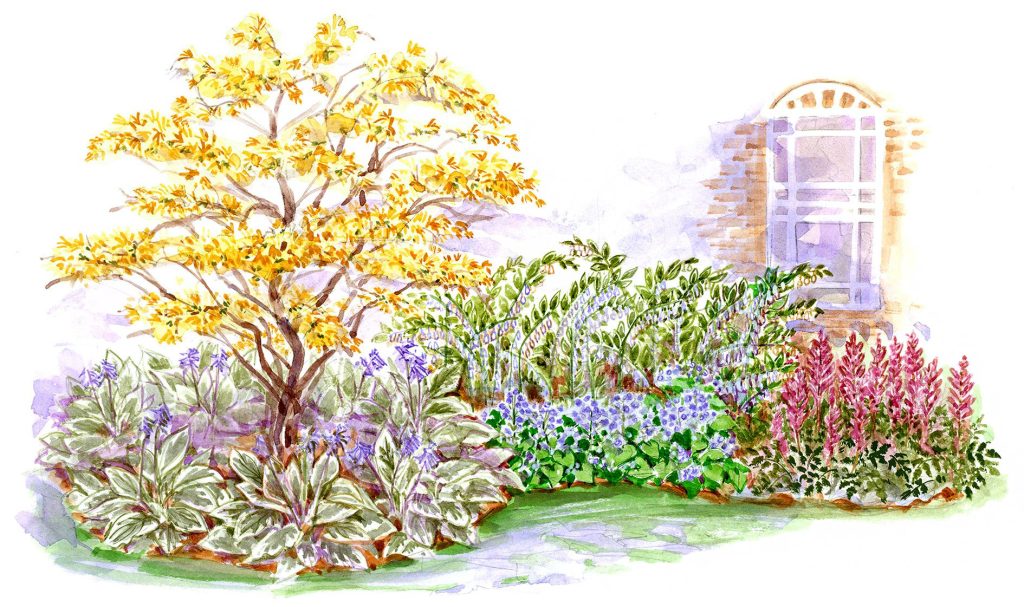
So I guess one of my things is to minimise the number of garden beds and maximise the impact of the overall garden. So as you minimise you can increase the size of one of the garden beds or two of the garden beds and then minimise the size or even the existence of the other one. And then you tend to maximise your impact.
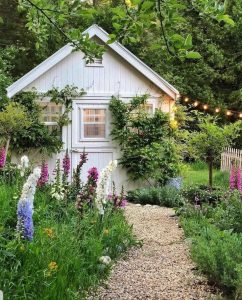 See a garden is a bit like a canvas for an artist isn’t it really? Yeah, that’s right, it is. So by doing lots of little garden beds everywhere you’re creating a high maintenance, low impact garden. Also it’s going to spread your attention all over the place with small plants all competing for attention. But with a big garden bed you can focus your attention on it because it’s a real feature and it creates a real impact.
See a garden is a bit like a canvas for an artist isn’t it really? Yeah, that’s right, it is. So by doing lots of little garden beds everywhere you’re creating a high maintenance, low impact garden. Also it’s going to spread your attention all over the place with small plants all competing for attention. But with a big garden bed you can focus your attention on it because it’s a real feature and it creates a real impact.
So concentrating everything in your garden into one or two really big areas and getting rid of all the little odds and ends of garden is a great thing that I really like to do.
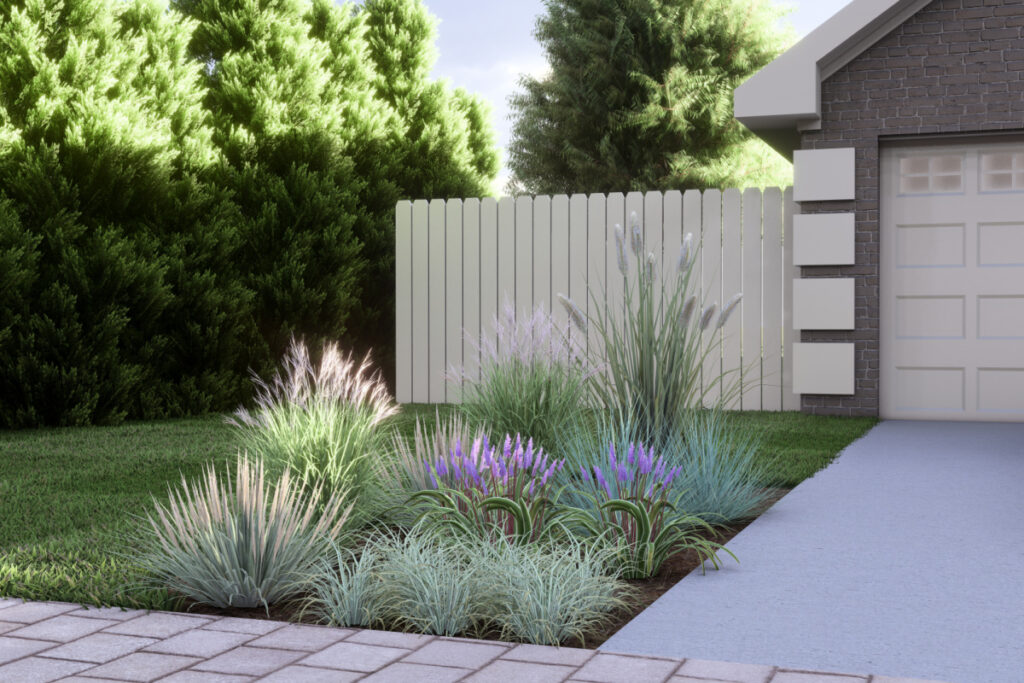
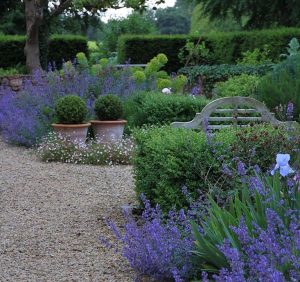 I guess the other thing with a lot of gardens is that they are way too complex and I think that simple, but bold gardens are the way to go. So what I’ll do is I’ll look at a garden and I’ll think of a theme and then I’ll tend to repeat that theme. And it could be a really simple thing such as I like really hot pink carpet roses. So often if you’ve got a driveway and there’s a garden bed on both sides of the driveway and another up the side of the house, what I’ll do is I’ll put in something like say your Pink Carpet Rose that flowers at the same time as your Dwarf English lavender. So I’ll put a little clumps of Dwarf English Lavender and Pink Carpet Roses in five places all over that front garden.
I guess the other thing with a lot of gardens is that they are way too complex and I think that simple, but bold gardens are the way to go. So what I’ll do is I’ll look at a garden and I’ll think of a theme and then I’ll tend to repeat that theme. And it could be a really simple thing such as I like really hot pink carpet roses. So often if you’ve got a driveway and there’s a garden bed on both sides of the driveway and another up the side of the house, what I’ll do is I’ll put in something like say your Pink Carpet Rose that flowers at the same time as your Dwarf English lavender. So I’ll put a little clumps of Dwarf English Lavender and Pink Carpet Roses in five places all over that front garden.
Then when they’re flowering together in the summer, that whole garden is just pulled together with a theme. It’s got that pink and mauve all the way around.
Now there’s thousands of ways of creating a theme and putting it through everything. And whether you’re starting a garden from scratch or replanting one, it’s really good to pick out some nice little combination of plants.
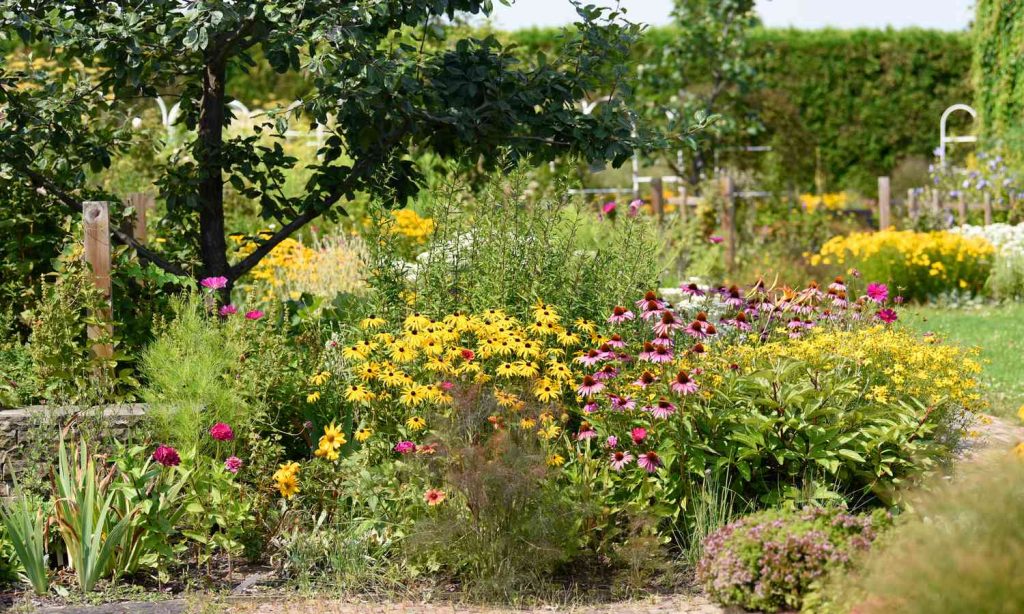
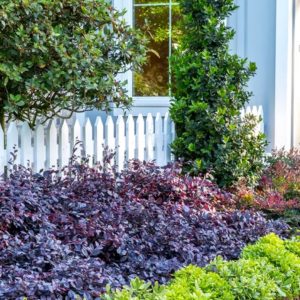 One of my favourite combinations starts with a fun, gorgeous plant called Loropetalum, which has a beautiful deep purple leaf. And then there’s a thing called Abelia Kaleidoscope, which has a brilliant yellow leaf, sort of a variegated leaf. When you put these two together or you even put them together with a silver plant, like a Silver Bush, and put them in five different spots all over the garden and all of a sudden you’ve taken a garden that might not be tied together at all and you’ve actually pulled that whole garden together and it all becomes one.
One of my favourite combinations starts with a fun, gorgeous plant called Loropetalum, which has a beautiful deep purple leaf. And then there’s a thing called Abelia Kaleidoscope, which has a brilliant yellow leaf, sort of a variegated leaf. When you put these two together or you even put them together with a silver plant, like a Silver Bush, and put them in five different spots all over the garden and all of a sudden you’ve taken a garden that might not be tied together at all and you’ve actually pulled that whole garden together and it all becomes one.
Now this is becoming particularly important these days with subdivisions being so small as people are subdividing big blocks into little blocks. As a result a lot of gardens are now really, really small. So if you are blessed with a nice wide garden or a nice big garden, I reckon you should flaunt it because where once a big garden was a bit “so what?” but now a lot of gardens are getting very, very small. So if you’ve got a big garden, put a theme in it.
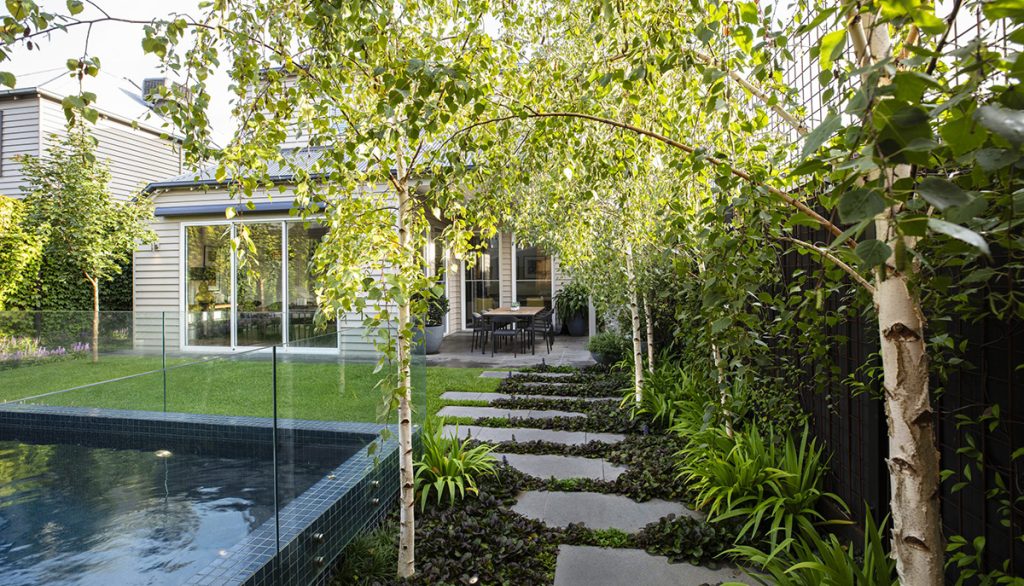
A theme that I like to do often starts with Silver Birches. You put a Silver Birch over here and a Silver Birch over there and they sort of shine out. Then you might put one in combination with a particular plant or put them up the front or down the back or all over the place and all of a sudden you’re showing off your nice big block of land because you’ve got it.
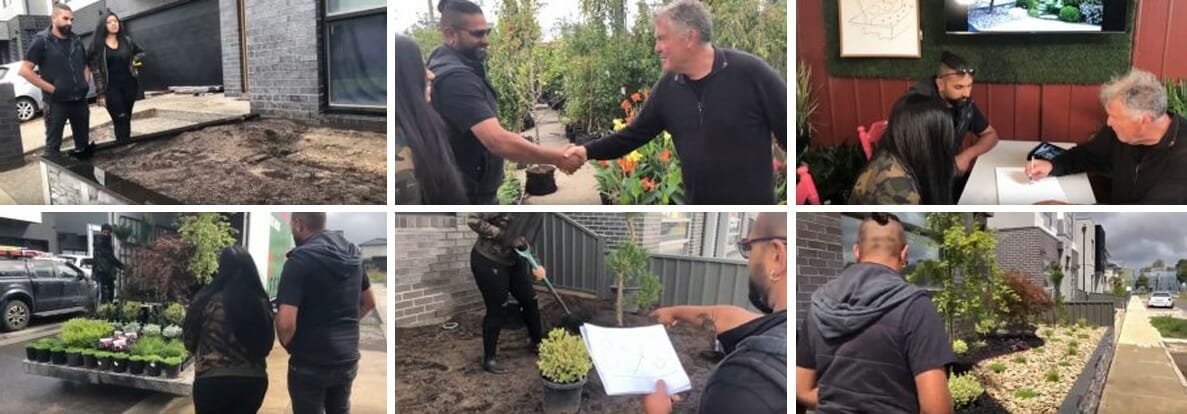 Often I’ll see something there that the people haven’t even seen themselves. Or I’ll capture some aspect of the garden or the home or something like that. It’s funny because some people start and they’re quiet and don’t have a lot to say at the start of the garden design but as we get talking, they start getting really, really emotional because they suddenly see how they can have what they always really wanted or suddenly that outcome becomes realised. And I’ve had people laughing and almost crying and all sorts of things during the garden design because suddenly we have a breakthrough and then we get to someplace where they never thought they could get to. And they go… wow!
Often I’ll see something there that the people haven’t even seen themselves. Or I’ll capture some aspect of the garden or the home or something like that. It’s funny because some people start and they’re quiet and don’t have a lot to say at the start of the garden design but as we get talking, they start getting really, really emotional because they suddenly see how they can have what they always really wanted or suddenly that outcome becomes realised. And I’ve had people laughing and almost crying and all sorts of things during the garden design because suddenly we have a breakthrough and then we get to someplace where they never thought they could get to. And they go… wow!
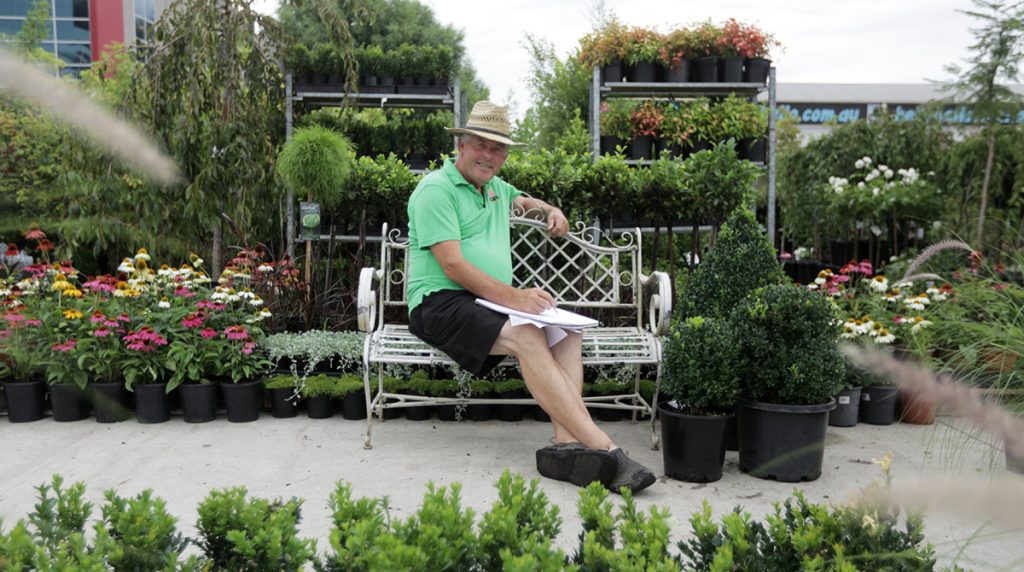
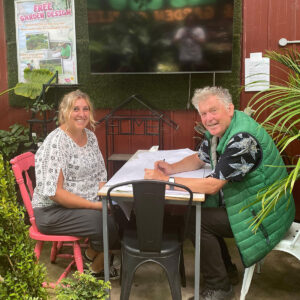 Now for somebody who comes to me for a garden design and they say they have absolutely no clue, they’ve just got their place and they don’t know what to do with it. Well what I start with is I always just ask them what is the outcome that you want. So do you want your garden to be low maintenance or do you want it to make the house look friendly from the street or do you want lots of colour or do you want a garden where you can go out and pick flowers all the time. You just have to say whatever it needs to be. And as long as I have an outcome that you want and a budget then you don’t have to think much about it beforehand. Just come along and book your 20 minutes or 45 minutes.
Now for somebody who comes to me for a garden design and they say they have absolutely no clue, they’ve just got their place and they don’t know what to do with it. Well what I start with is I always just ask them what is the outcome that you want. So do you want your garden to be low maintenance or do you want it to make the house look friendly from the street or do you want lots of colour or do you want a garden where you can go out and pick flowers all the time. You just have to say whatever it needs to be. And as long as I have an outcome that you want and a budget then you don’t have to think much about it beforehand. Just come along and book your 20 minutes or 45 minutes.
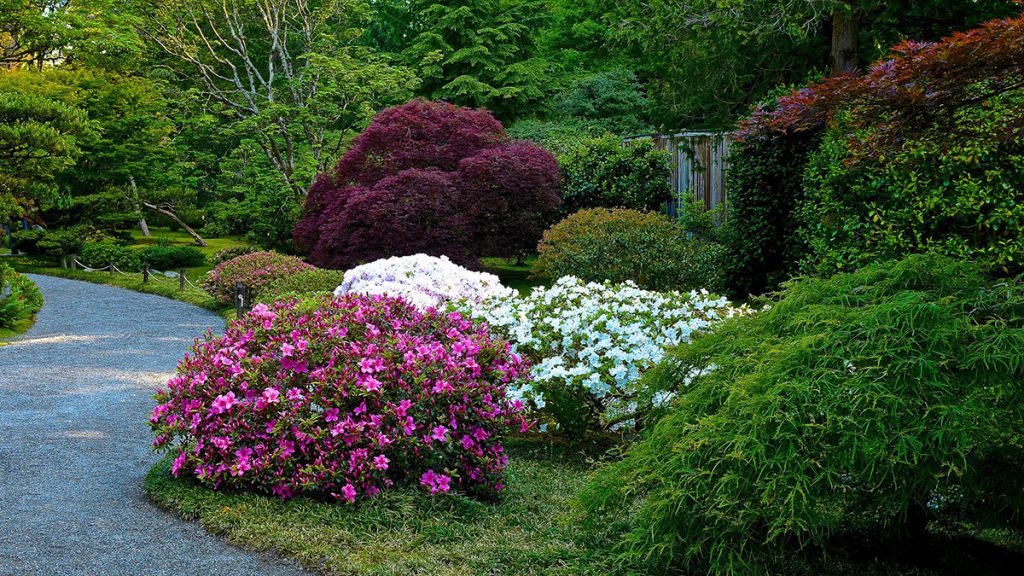
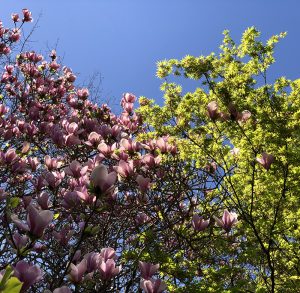 I guess another aspect of garden design is there’s things that you have to balance in a garden. Like for instance, I might get someone who comes in and they love Japanese Maples. Lots of people come in who love Japanese Maples. But the problem with Japanese maples is they lose their leaves in the winter. And if you plant up too many Japanese Maples, the whole garden can become a bit desolate. So you might put some evergreen Magnolias with the Japanese Maples, or I’ll use some Dwarf Japanese Pines. See it’s important to balance your deciduous with your evergreen. I mean when you get too many evergreens, you often can become a bit colourless. A lot of your excitement and a lot of your really interesting things comes with deciduous plants in a garden.
I guess another aspect of garden design is there’s things that you have to balance in a garden. Like for instance, I might get someone who comes in and they love Japanese Maples. Lots of people come in who love Japanese Maples. But the problem with Japanese maples is they lose their leaves in the winter. And if you plant up too many Japanese Maples, the whole garden can become a bit desolate. So you might put some evergreen Magnolias with the Japanese Maples, or I’ll use some Dwarf Japanese Pines. See it’s important to balance your deciduous with your evergreen. I mean when you get too many evergreens, you often can become a bit colourless. A lot of your excitement and a lot of your really interesting things comes with deciduous plants in a garden.
Also a lot of people, if they have a native garden for example, they really enjoy it when I add a little bit of exotic colour in there, like a Mexican Sage or something like that. Because a little bit of exotic colour can really liven a native garden. (Of course that doesn’t sort suit the native purist!)
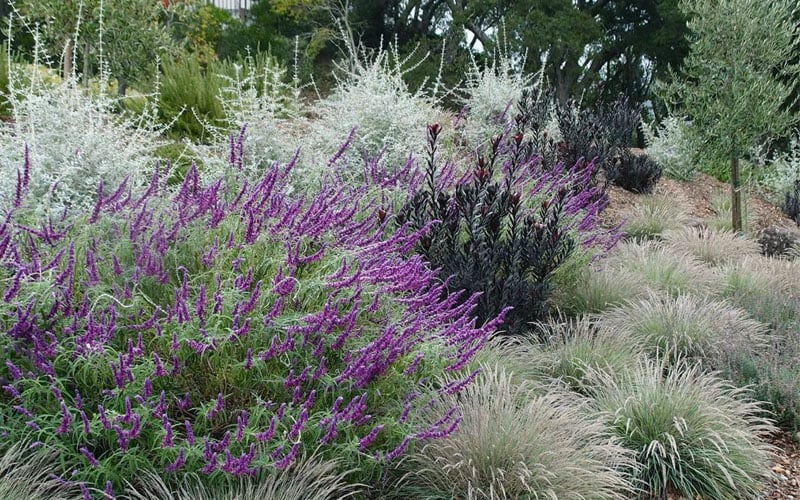
Often in my Japanese gardens I’ll use a lot of Australian native grasses as they are much hardier than the Japanese grasses and a little bit more showy. So I’ll use them to balance it a bit. Because often you don’t necessarily want everything in a garden all flowering at one time. Remember that when you’re shopping for plants, if you walk into a nursery in the middle of summer and you buy 10 plants that are all beautifully in flower then, remember that your garden could be quite colourless in winter because these were all summer flowering plants that you bought.
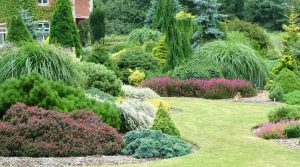 So there are often aspects to a garden where you have to think of things beyond what you see right there at the time. You have to balance things. You have to know that this plant here is deciduous and you need some evergreen over there. Or that these plants are all in flower now, but they’re not all going to be in flower later when you want a bit of colour in your garden. So there are many sorts of things that you have to balance to make really good decisions.
So there are often aspects to a garden where you have to think of things beyond what you see right there at the time. You have to balance things. You have to know that this plant here is deciduous and you need some evergreen over there. Or that these plants are all in flower now, but they’re not all going to be in flower later when you want a bit of colour in your garden. So there are many sorts of things that you have to balance to make really good decisions.
Another thing to think about is what type of soil you have in your garden. If you’re coming in for a garden design, it’s worth bringing in a little bit of soil from the top of your garden and a bit from down beneath. Because this could determine the variety of plants I recommend. I had someone come in the other day and tell me their garden and their plants had been affected by flooding. So I said to her, you’ve got a choice here. You can either hire a plumber to put in some very expensive drainage and drain it all out or it would be much cheaper to just put in flood tolerant plants. We ended up selecting some grasses and willow trees and things like that and they went for a cheap solution, which was your flood tolerant plants.
So when thinking about your garden, remember to take stock of your assets and liabilities first. Make some tough decisions. Get rid of the liabilities. If there isn’t room for a lawn AND a garden, have no lawn. If you have a lawn, don’t put a tree in the middle of it. And finally reduce the number of garden beds and maximise the impact.
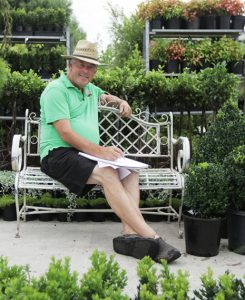 Just one final thing, if you walk around the neighbourhood and see what everyone else is doing, don’t just copy them exactly. Do something a little bit different. Be a bit bold! And create something wonderful.
Just one final thing, if you walk around the neighbourhood and see what everyone else is doing, don’t just copy them exactly. Do something a little bit different. Be a bit bold! And create something wonderful.
And if you don’t feel you can do it all yourself, then contact us and book in a Free Garden Design with me. I look forward to seeing what you create!



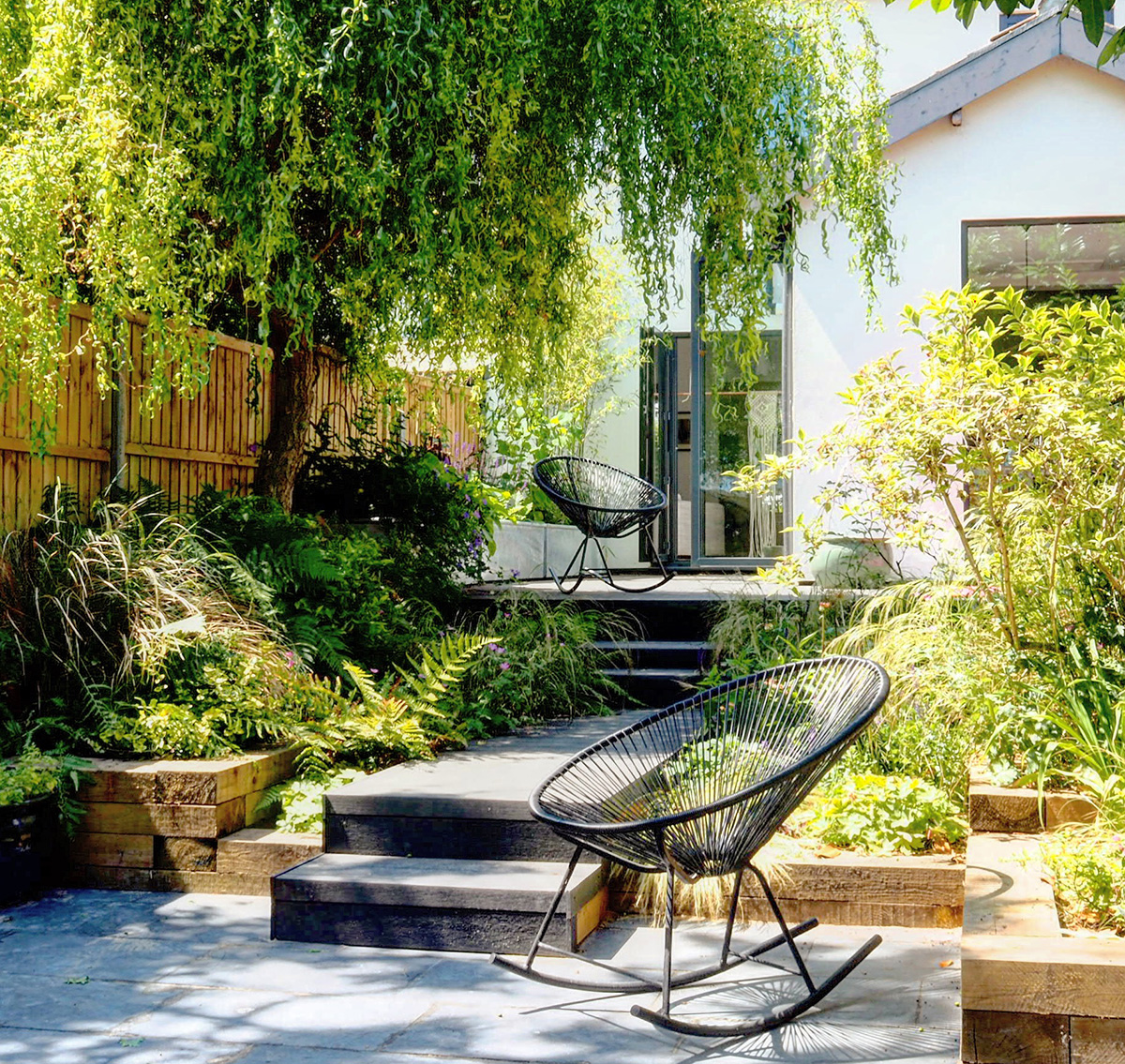
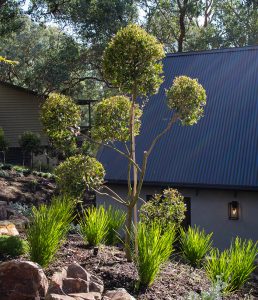 Now each time I design a garden, I actually have a process that I go through. I remember I had a job when I first left high school and I was fixing up gardens for a local real estate agent up in the hills for houses that had been sort of abandoned, when their prices were terrible. But then prices started going up so the people would go in and get their gardens fixed up so they could put their houses back on the market. I was doing that when I was just 17 so it’s actually more than 40 years I just realised!! So, I’ve got quite a long history of designing gardens.
Now each time I design a garden, I actually have a process that I go through. I remember I had a job when I first left high school and I was fixing up gardens for a local real estate agent up in the hills for houses that had been sort of abandoned, when their prices were terrible. But then prices started going up so the people would go in and get their gardens fixed up so they could put their houses back on the market. I was doing that when I was just 17 so it’s actually more than 40 years I just realised!! So, I’ve got quite a long history of designing gardens.